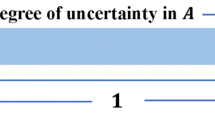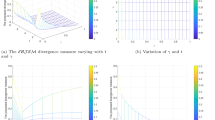Abstract
Dempster–Shafer (D–S) evidence theory is widely used in the field of uncertain information processing, but because of its defective fusion rules, it often results in visual violations when dealing with highly conflicting evidence. To solve the conflict management problem of D–S theory, an improved belief \(\chi 2\) divergence (called \({\mathcal {I}}{\mathcal {B}}\chi ^2\)) is proposed in this paper. The \({\mathcal {I}}{\mathcal {B}}\chi ^2\) divergence takes into account the amount of all possible hypotheses, which allow it be a more credible and efficient solution to measure the dissimilarity between evidences. Moreover, it has good mathematical properties including symmetry, boundedness and non-degeneracy. Next, we designed a novel multi-resource information fusion algorithm based on \({\mathcal {I}}{\mathcal {B}}\chi ^2\) divergence. Finally, application in automobile system fault recognition and iris feature recognition prove the effectiveness and accuracy of the proposed multi-resource information fusion algorithm.








Similar content being viewed by others
Notes
A Generalized \(\chi \)2 Divergence for multisource Information Fusion.
References
Babajanyan S, Allahverdyan A, Cheong KH (2020) Energy and entropy: path from game theory to statistical mechanics. Phys Rev Res 2(4):043055
Cao Z, Chuang C-H, King J-K, Lin C-T (2019) Multi-channel EEG recordings during a sustained-attention driving task. Sci Data. https://doi.org/10.1038/s41597-019-0027-4
Chang L, Zhang L, Fu C, Chen Y-W (2021) Transparent digital twin for output control using belief rule base. IEEE Trans Cybern. https://doi.org/10.1109/TCYB.2021.3063285
Chen L, Deng Y, Cheong KH (2021) Probability transformation of mass function: a weighted network method based on the ordered visibility graph. Eng Appl Artif Intell 105:104438
Cheng C, Xiao F (2021) A distance for belief functions of orderable set. Pattern Recogn Lett 145:165–170
Cui H, Zhou L, Li Y, Kang B (2022) Belief entropy-of-entropy and its application in the cardiac interbeat interval time series analysis. Chaos Solitons Fractals 20:20
Dempster AP (1967) Upper and lower probabilities induced by a multivalued mapping. Ann Math Stat 38(2):325–339
Deng Y (2020) Uncertainty measure in evidence theory. Sci China Inf Sci 63(11):210201
Deng Y (2020) Information volume of mass function. Int J Comput Commun Control 15(6):3983
Deng X, Deng Y (2019) D-AHP method with different credibility of information. Soft Comput 23(2):683–691
Deng J, Deng Y (2021) Information volume of fuzzy membership function. Int J Comput Commun Control 16(1):4106
Deng Y, Shi W, Zhu Z, Liu Q (2004) Combining belief functions based on distance of evidence. Decis Support Syst 38(3):489–493
Ejegwa PA, Agbetayo JM (2022) Similarity-distance decision-making technique and its applications via intuitionistic fuzzy pairs. J Comput Cogn Eng 20:20
Eymard R, Guichard C (2018) Discontinuous galerkin gradient discretisations for the approximation of second-order differential operators in divergence form. Comput Appl Math 37(4):4023–4054
Fei L, Feng Y (2021) Intuitionistic fuzzy decision-making in the framework of Dempster–Shafer structures. Int J Intell Syst 36(10):5419–5448
Fu C, Chang W, Yang S (2020) Multiple criteria group decision making based on group satisfaction. Inf Sci 518:309–329
Fujita H, Ko Y-C (2020) A heuristic representation learning based on evidential memberships: case study of UCI-SPECTF. Int J Approx Reason 20:120
Fujita H, Gaeta A, Loia V, Orciuoli F (2020) Hypotheses analysis and assessment in counter-terrorism activities: a method based on OWA and fuzzy probabilistic rough sets. IEEE Trans Fuzzy Syst 28:831–845
Gao X, Deng Y (2020) The pseudo-pascal triangle of maximum Deng entropy. Int J Comput Commun Control 15(1):1006
Gao X, Pan L, Deng Y (2021) A generalized divergence of information volume and its applications. Eng Appl Artif Intell 108:104584. https://doi.org/10.1016/j.engappai.2021.104584
Gao X, Su X, Qian H, Pan X (2021) Dependence assessment in human reliability analysis under uncertain and dynamic situations. Nucl Eng Technol. https://doi.org/10.1016/j.net.2021.09.045
Gao Q, Wen T, Deng Y (2021) Information volume fractal dimension. Fractals. https://doi.org/10.1142/S0218348X21502637
Garg H (2021) Cn-q-rofs: connection number-based q-rung orthopair fuzzy set and their application to decision-making process. Int J Intell Syst 36(7):3106–3143
Garg H (2022) Svnmpr: a new single-valued neutrosophic multiplicative preference relation and their application to decision-making process. Int J Intell Syst 37(3):2089–2130
Garg H, Kaur G (2022) Algorithm for solving the decision-making problems based on correlation coefficients under cubic intuitionistic fuzzy information: a case study in watershed hydrological system. Complex Intell Syst 8(1):179–198
Garg H, Rani D (2021) Novel exponential divergence measure of complex intuitionistic fuzzy sets with an application to the decision-making process. Sci Iran 28(4):2439–2456
Garg H, Rani D (2022) An efficient intuitionistic fuzzy multimoora approach based on novel aggregation operators for the assessment of solid waste management techniques. Appl Intell 52(4):4330–4363
Garon EM, Lambers JV (2018) Modeling the diffusion of heat energy within composites of homogeneous materials using the uncertainty principle. Comput Appl Math 37(3):2566–2587
Han D, Dezert J, Yang Y (2016) Belief interval-based distance measures in the theory of belief functions. IEEE Trans Syst Man Cybern Syst 48(6):833–850
Jiang W, Wei B, Xie C, Zhou D (2016) An evidential sensor fusion method in fault diagnosis. Adv Mech Eng 8(3):1687814016641820
Jiang W, Cao Y, Deng X (2020) A novel Z-network model based on Bayesian network and Z-number. IEEE Trans Fuzzy Syst 28(8):1585–1599. https://doi.org/10.1109/TFUZZ.2019.2918999
Joshi R, Kumar S (2018) An (R, S)-norm fuzzy information measure with its applications in multiple-attribute decision-making. Comput Appl Math 37(3):2943–2964
Khan F, Shakeel M, Abdullah S (2019) Ranking methodology of irrigation problems based on pythagorean trapezoidal fuzzy aggregations operators. Comput Appl Math 38(3):1–20
Lai JW, Chang J, Ang L, Cheong KH (2020) Multi-level information fusion to alleviate network congestion. Inf Fusion 63:248–255
Liu Z, Liu Y, Dezert J, Cuzzolin F (2020) Evidence combination based on credal belief redistribution for pattern classification. IEEE Trans Fuzzy Syst 28(4):618–631
Liu P, Shen M, Teng F, Zhu B, Rong L, Geng Y (2021) Double hierarchy hesitant fuzzy linguistic entropy-based TODIM approach using evidential theory. Inf Sci 547:223–243
Meng D, Lv Z, Yang S, Wang H, Xie T, Wang Z (2021) A time-varying mechanical structure reliability analysis method based on performance degradation. Structures, vol 34. Elsevier, New York, pp 3247–3256
Meng D, Wang H, Yang S, Lv Z, Hu Z, Wang Z (2022) Fault analysis of wind power rolling bearing based on EMD feature extraction. Comput Model Eng Sci 130(1):543–558
Murphy CK (2000) Combining belief functions when evidence conflicts. Decis Support Syst 29(1):1–9
Ni L, Chen Y-W, de Brujin O (2021) Towards understanding socially influenced vaccination decision making: an integrated model of multiple criteria belief modelling and social network analysis. Eur J Oper Res 293(1):276–289
Qian J, Guo X, Deng Y (2017) A novel method for combining conflicting evidences based on information entropy. Appl Intell 46(4):876–888
Riaz M, Tehrim ST (2019) Cubic bipolar fuzzy ordered weighted geometric aggregation operators and their application using internal and external cubic bipolar fuzzy data. Comput Appl Math 38(2):1–25
Saeed M, Ahmad MR, Rahman AU (2022) Refined pythagorean fuzzy sets: properties, set-theoretic operations and axiomatic results. J Comput Cogn Eng 20:20
Singh P (2017) Distance and similarity measures for multiple-attribute decision making with dual hesitant fuzzy sets. Comput Appl Math 36(1):111–126
Song Y, Deng Y (2021) Entropic explanation of power set. Int J Comput Commun Control 16(4):4413
Song X, Xiao F (2022) Combining time-series evidence: a complex network model based on a visibility graph and belief entropy. Appl Intell. https://doi.org/10.1007/s10489-021-02956-5
Song Y, Fu Q, Wang Y-F, Wang X (2019) Divergence-based cross entropy and uncertainty measures of Atanassov’s intuitionistic fuzzy sets with their application in decision making. Appl Soft Comput 84:105703
Tang S-W, Zhou Z-J, Hu C-H, Yang J-B, Cao Y (2021) Perturbation analysis of evidential reasoning rule. IEEE Trans Syst Man Cybern Syst 51(8):4895–4910
Tao R, Liu Z, Cai R, Cheong KH (2021) A dynamic group MCDM model with intuitionistic fuzzy set: perspective of alternative queuing method. Inf Sci 555:85–103
Wang Z, Xiao F (2019) An improved multi-source data fusion method based on the belief entropy and divergence measure. Entropy 21(6):611
Wang Z, Wang C, Li X, Gao C, Li X, Zhu J (2020) Evolutionary Markov dynamics for network community detection. IEEE Trans Knowl Data Eng. https://doi.org/10.1109/TKDE.2020.2997043
Wang Z, Wang C, Gao C, Li X, Li X (2020) An evolutionary autoencoder for dynamic community detection. Sci China Inf Sci 63(11):1–16
Wang Z, Li Z, Wang R, Nie F, Li X (2021) Large graph clustering with simultaneous spectral embedding and discretization. IEEE Trans Pattern Anal Mach Intell 43(12):4426–4440. https://doi.org/10.1109/TPAMI.2020.3002587
Wang Z, Dai X, Zhu P, Wang R, Li X, Nie F (2021) Fast optimization of spectral embedding and improved spectral rotation. IEEE Trans Knowl Data Eng. https://doi.org/10.1109/TKDE.2021.3098806
Wang Z, Xiao F, Ding W (2022) Interval-valued intuitionistic fuzzy Jenson–Shannon divergence and its application in multi-attribute decision making. Appl Intell. https://doi.org/10.1007/s10489-022-03347-0
Wen T, Cheong KH (2021) The fractal dimension of complex networks: a review. Inf Fusion 73:87–102
Wu Z, Liao H (2021) A consensus reaching process for large-scale group decision making with heterogeneous preference information. Int J Intell Syst. https://doi.org/10.1002/int.22469
Xiao F (2019) Multi-sensor data fusion based on the belief divergence measure of evidences and the belief entropy. Inf Fusion 46:23–32
Xiao F, Pedrycz W (2022) Negation of the quantum mass function for multisource quantum information fusion with its application to pattern classification. IEEE Trans Pattern Anal Mach Intell. https://doi.org/10.1109/TPAMI.2022.3167045
Xiao F, Wen J, Pedrycz W (2022) Generalized divergence-based decision making method with an application to pattern classification. IEEE Trans Knowl Data Eng. https://doi.org/10.1109/TKDE.2022.3177896
Xie D, Xiao F, Pedrycz W (2021) Information quality for intuitionistic fuzzy values with its application in decision making. Eng Appl Artif Intell. https://doi.org/10.1016/j.engappai.2021.104568
Xiong L, Su X, Qian H (2021) Conflicting evidence combination from the perspective of networks. Inf Sci 580:408–418
Yager RR (2019) Generalized Dempster–Shafer structures. IEEE Trans Fuzzy Syst 27(3):428–435
Yager RR (2020) Using fuzzy measures for modeling human perception of uncertainty in artificial intelligence. Eng Appl Artif Intell 87:103228
Ye J, Zhan J, Ding W, Fujita H (2021) A novel fuzzy rough set model with fuzzy neighborhood operators. Inf Sci 544:266–297
Zhang L, Xiao F (2022) A novel belief \(\chi \)2 divergence for multisource information fusion and its application in pattern classification. Int J Intell Syst. https://doi.org/10.1002/int.22912
Zhang Z, Xu X, Chen P, Wu X, Xu X, Wang G (2021) A novel nonlinear causal inference approach using vector-based belief rule base. Int J Intell Syst. https://doi.org/10.1002/int.22500
Zhou Q, Mo H, Deng Y (2020) A new divergence measure of pythagorean fuzzy sets based on belief function and its application in medical diagnosis. Mathematics 8:1. https://doi.org/10.3390/math8010142
Zhou M, Chen Y-W, Liu X-B, Cheng B-Y, Yang J-B (2020) Weight assignment method for multiple attribute decision making with dissimilarity and conflict of belief distributions. Comput Ind Eng 147:106648
Zhu C, Xiao F, Cao Z (2022) A generalized Rényi divergence for multi-source information fusion with its application in EEG data analysis. Inf Sci. https://doi.org/10.1016/j.ins.2022.05.012
Acknowledgements
The authors greatly appreciate the reviewers’ suggestions and the editor’s encouragement. This research is supported by the National Natural Science Foundation of China (No. 62003280), Chongqing Talents: Exceptional Young Talents Project (cstc2022ycjh-bgzxm0070), and Chongqing Overseas Scholars Innovation Program (No. cx2022024).
Author information
Authors and Affiliations
Corresponding author
Additional information
Communicated by Graçaliz Pereira Dimuro.
Publisher's Note
Springer Nature remains neutral with regard to jurisdictional claims in published maps and institutional affiliations.
This paper is an extension of conference paper A Generalized \(\chi ^2\) Divergence for Multisource Information Fusion
Rights and permissions
Springer Nature or its licensor holds exclusive rights to this article under a publishing agreement with the author(s) or other rightsholder(s); author self-archiving of the accepted manuscript version of this article is solely governed by the terms of such publishing agreement and applicable law.
About this article
Cite this article
Gao, X., Xiao, F. An improved belief \(\chi ^2\) divergence for Dempster–Shafer theory and its applications in pattern recognition. Comp. Appl. Math. 41, 277 (2022). https://doi.org/10.1007/s40314-022-01975-3
Received:
Revised:
Accepted:
Published:
DOI: https://doi.org/10.1007/s40314-022-01975-3
Keywords
- Multi-resource information fusion
- Dempster–Shafer theory
- \(\chi ^2\) divergence
- Belief \(\chi ^2\) divergence
- Pattern recognition




